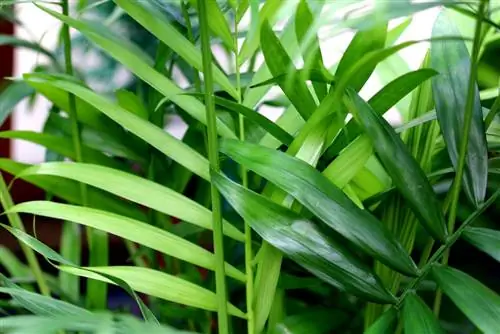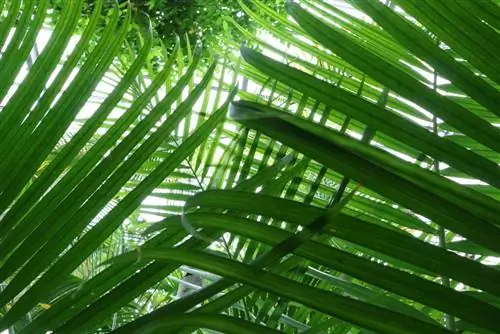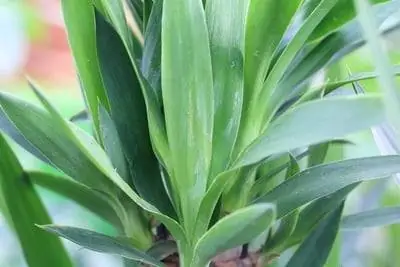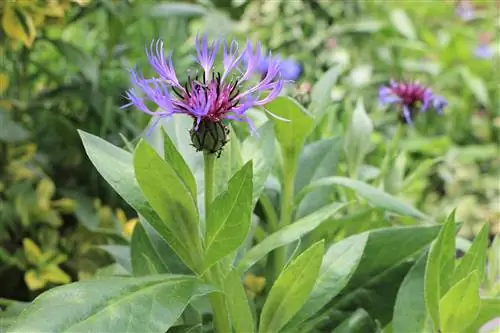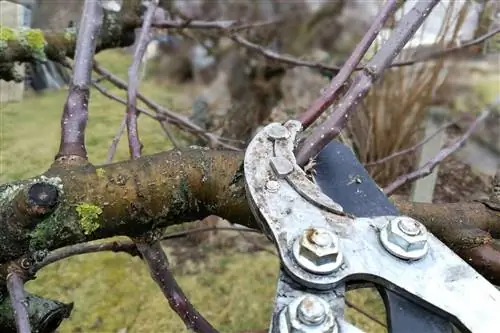- Author admin [email protected].
- Public 2023-12-17 03:39.
- Last modified 2025-01-24 12:45.
The mountain palm has the botanical name Chamaedorea elegans and originally comes from Central America. Thanks to its easy-care and robust properties, the plant has established itself as a popular houseplant in this country. If the site conditions and care are right, the palm tree will thrive. However, certain mistakes in these areas are better avoided, otherwise the plant will grow poorly.
Location
The mountain palm is native to the mountainous regions of Mexico and Guatemala. The plant grows there mainly as an understory in the light-flooded shade of the forests. That's why Chamaedorea elegans prefers a bright location, but it doesn't cope well with too much sunlight. The plant is ideal as a houseplant for local latitudes, but due to its lack of winter hardiness it cannot spend the whole year in the garden. However, the palm feels very comfortable at normal room temperatures. During the warm months, the plant can temporarily move outdoors; it thrives well in sheltered places on the balcony, terrace or in the garden. However, the preferred location conditions should also prevail here.
- Partly sunny places are optimal
- The ideal location is on the east or west window
- Bright midday heat is not tolerated at all
- Prefers temperature values between 15 to 25° C
- Can also cope with partial shade and shade
- Then the palm tree grows much slower and weaker
Tip:
If a south-facing window is chosen as the place for the palm tree, then it relies on additional sun protection during midday. Pulled down roller shutters, awnings or a blackout curtain are suitable for this.
Planting substrate
The conventional commercial garden and potting soil is not particularly suitable for the mountain palm. Therefore, you should create a suitable mixture of soil and other components yourself so that the plant can feel comfortable. If the Chamaedorea elegans has grown a little larger, it needs more stability in the planting substrate. In addition, the planter must have a sufficiently large outlet hole, otherwise waterlogging can quickly form and the roots begin to mold.
- Permeable plant substrate is ideal
- Cools well with slightly alkaline pH levels
- But also tolerates slightly acidic soil qualities
- Preferably a mixture of leaf mold, compost and some sand
- For older specimens, mix in clay-containing garden soil
- Create drainage from potsherds or small pebbles
- Only then spread the planting substrate over it
Watering & Fertilizing
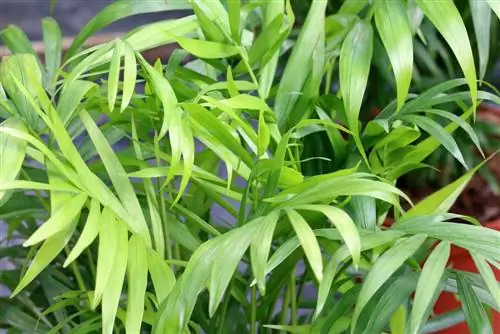
The mountain palm has a high water requirement during the growing season. In its ancestral homeland, it develops a pronounced root system that reaches down to the groundwater. If the plant is too dry, it will not thrive. The leaves dry out and, in extreme cases, the palm tree can even die completely. If you tend to be forgetful when watering, you should use additional water supply systems for your houseplants. The root ball may even be watered too much from time to time, but this condition should not be permanent. During the hot months, the planter with the palm tree can be placed in a water bath about every two weeks so that the roots can completely soak up moisture. The plant does not have high demands on nutrients and can cope with conventional fertilizer.
- Make sure you water regularly
- Must be watered a lot, especially at high temperatures
- Also tolerates hard water from the tap
- However, avoid permanent waterlogging
- Spray palm fronds with water mist every now and then
- Hydroponics or pots with an irrigation system are ideal
- Has normal nutritional requirements
- Fertilize during the growing season from April to the end of August
- Administer normal liquid fertilizer twice a month
- However, only use this in half the concentration
Tip:
If the flower pot is in a matching base, then this bowl should be checked periodically. If excess irrigation water collects there, the water must always be removed promptly.
Repotting
When the mountain palms are still young, they grow significantly faster. If the site conditions, care and substrate are also right, then the planter will quickly become too small for the plant. In this case, the plants must be repotted promptly. However, if you use containers that are too large right from the start, you will disrupt the growth rhythm of the palm tree. Over time, growth slows down significantly in older specimens. When repotting, it is advisable to be extremely careful so that the delicate root system is not damaged. The palm tree consists of several specimens that were put together to form small tuffs and then planted in a container. In this way, the entire plant never dies when damaged, but the attractive and dense growth habit is often lost if some parts of the plant die.
- Repot only when roots grow out of the pot
- These should stick out from the bottom or top
- Do not proceed too early to avoid disturbing the plant
- Young specimens need to be repotted almost every year
- Best time of year for repotting is early spring
- Slightly taller pots are ideal
- Palm tree roots grow more in depth than in width
- Always create drainage in the bottom of the pot
Cutting
Mountain palms typically do not require pruning. The plant grows very slowly, but steadily; it can reach heights of up to 150 cm. However, dead plant parts should be removed immediately so that new shoots can develop undisturbed. Since the flower has a major influence on the growth of the palm tree, it should be removed early if propagation is not desired. Otherwise, the plant puts all its growth power into the development of the flowers and the growth of the shoots noticeably stagnates.
- Cut off old, brown and dried palm fronds
- Don't cut off too much at once to protect the plant
- Make the cut on flower stems as far down as possible
- Without flowers, palm tree continues to grow normally
Wintering
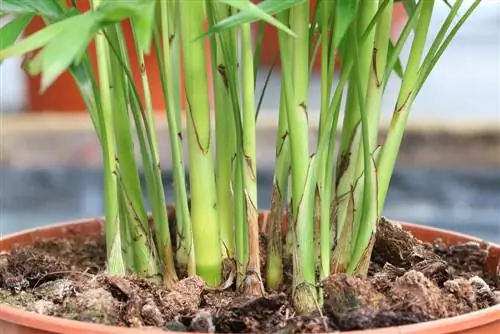
Mountain palms begin hibernation early and then require special care. Since the plants are not winter hardy, they cannot stay outside all year round in these latitudes. If the palm tree is kept outside as a potted plant in the summer months, it must be moved to suitable winter quarters. The move must take place in good time, before the outside temperatures permanently fall below 10° C. Otherwise, the plant can be damaged if the temperature is too cool. The winter quarters you choose should not be too dark, otherwise the shoots will wither and the color of the leaves will fade. In addition, the mountain palm cannot cope in heated living spaces in winter, as it then becomes more susceptible to pests.
- Winter rest lasts from October to February
- During this phase, room temperatures of 12° to 15° C are ideal
- Good winter quarters are unheated winter gardens
- Alternatively, stay in bright basement rooms or corridors
- Feels comfortable even in unused guest rooms
- Don't place it too sunny
- Water little in winter
- Do not administer fertilizer
- Make sure there is sufficient humidity
- Spray palm tree regularly with water mist
- Air winter quarters periodically to avoid mold
Propagate
Since mountain palms do not produce fruit as houseplants, they can be propagated using cuttings. If Chamaedorea elegans is grown outdoors as a potted plant, seeds can certainly form. However, this process of reproduction is very difficult and laborious to carry out.
- Separate side shoots at the base of the palm tree
- Use germ-free potting soil
- Carefully insert cuttings into soil
- Ideal temperature values are 24 to 26° C
- Bright location, but definitely not too sunny
- Always keep the soil slightly moist
- Do not fertilize initially
- This stimulates root growth
Diseases & Pests
Diseases are relatively rare with Chamaedorea elegans because the plant is very robust. The palm tree forgives minor care errors, but it reacts sensitively to incorrect location conditions and serious deviations in care. If the ambient air is too dry and the location is too cool, the tips of the palm fronds often become dried out. If the winter quarters are not suitable, pests quickly spread. These primarily include scale insects, spider mites and occasionally thrips. As a rule, these pests can be eliminated using harmless home remedies. However, if there is no improvement, then only chemical control agents often help. However, these are not tolerated well by the palm trees and permanently weaken the sensitive plants.
- Spider mites can be recognized by their fine webs
- These form both at the base and at the end of the fronds
- Pests prefer low humidity
- Wash these off with gentle soap
- Spray affected plants daily with water mist
- Scale insects are tiny and difficult to see
- Infestation manifests itself through secreted honeydew
- Sticky coating around the plant and container, often on the ground
- Rinse pests with soapy water
- Use chemical insecticides in extreme cases
- Repeat treatment more often
- This is the only way to destroy all developmental stages of the pests
Are mountain palms poisonous?
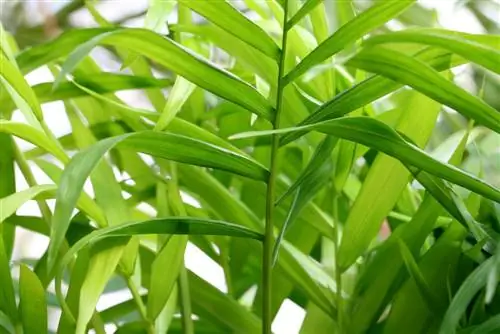
There is a popular rumor that the mountain palm is poisonous. The flowers and leaves are said to contain harmful saponins, which lead to problems in the stomach and intestines after consumption. However, the Zurich Institute for Veterinary Pharmacology and Toxicology has refuted this misconception. However, parents should always exercise caution, especially when the children are very young. Dogs and cats also like to stay near the palm trees and should not eat them.
- Is not poisonous according to the poisonous plant database
- Is listed there as a harmless plant for living rooms and balconies
- However, children should never play with houseplants without supervision
- Dogs and cats should not have contact with the mountain palm
- Avoid this situation by setting it up high
Popular species
In addition to the very popular Chamaedorea elegans, the Chamaedorea genus also includes over 100 other species, most of which are also not poisonous. Some of them grow even larger or significantly smaller, and they also differ in their optical properties. The mountain palm has so far become the most widespread houseplant.
- Chamaedorea metallica has a delicate growth habit
- Chamaedorea graminifolia forms very long leaves
- Chamaedorea ernesti-augustii is characterized by pinnate leaves
- Chamaedorea elegans Bella is one of the beautiful hybrids

